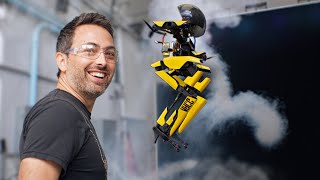CNET took a closer look at the Leonardo bot (LEgs ONboARD DrOne) introduced by bot developers at CalTech last year.
Leonardo was designed using drone technology and traditional robotic technology, which means the two-legged robot has the ability to walk and fly. In the clip above, you can also check out how the robot uses its drone to maintain its balance, something that can come in handy, for example, when the robot is walking a tightrope or going on a skateboard trip.
Researchers at Caltech have been developing Leonardo since 2019, but say they see continued development potential in the tiny robot. Among other things, they want to develop functionality so that the robot itself can decide when to use its legs, rotors, or a combination of these, something it does not have the ability to do today.
In the future, it is believed that robots like Leonardo can be used for inspections, for example, telephone lines and bridges. It is also noted that perhaps similar robots could be used on Mars or in other places with rugged terrain where it would be convenient for a robot to be able to fly and move on Earth.
caltech.edu
A robot that can fly and walk
Researchers at the California Institute of Technology have developed a drone they named Leonardo, short for “LEgs ONboARD,” which is equipped with legs. This means that Leonardo, or Leo as the robot-like creation is also called, can fly and walk. The idea behind it all is that the robot should be able to more easily navigate changing terrain. “Robots with multimodal locomotion are able to move through challenging environments more efficiently than conventional robots through appropriate switching between available means of locomotion,” says Kyunnam Kim, a researcher at Caltech who helped develop Leo. In particular, LEO aims to bridge the gap between the two disparate domains of air mobility and bipedalism that do not normally intertwine in current robotic systems.” Leo is approximately 75 cm tall and weighs only 2.58 kg. The researchers, among other things, drew inspiration from the Astro Boy animated series in connection with the development of the drone robot. It is believed that the technology behind Leo could be used in the future, for example, landing gear for flying vehicles and writes, among other things: “The team envisions that future Martian rotors could be equipped with legged landing gear so that the body can maintain These aerial robots balance as they land on sloping or uneven terrain, reducing the risk of failure under difficult landing conditions.” Below is a clip on Astro Boy.
39.9 degrees
More about Leonardo
A few weeks ago, we wrote about the robot Leonardo, who can do a lot of things. Here we take a closer look at the strange creation and talk with its creator.
38.4 degrees

“Unapologetic writer. Bacon enthusiast. Introvert. Evil troublemaker. Friend of animals everywhere.”








More Stories
More than 100 Republicans rule: Trump is unfit | World
Summer in P1 with Margrethe Vestager
Huge asteroid approaching Earth | World